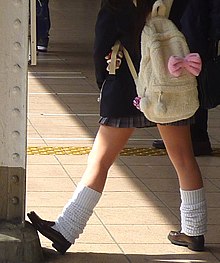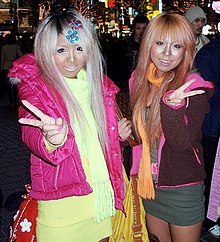The kogal (コギャル, kogyaru) fashion involves wearing an outfit based on a Japanese school uniform, but with a shortened skirt, loose socks, and often dyed hair and a scarf as well. The phenomenon was prominent in the 1990s, but has since declined. The word "kogal" is anglicized from kogyaru, a contraction of kÅkÅsei gyaru (high school gal). The girls refer to themselves as gyaru (gals), although this word is applied to several other fashion looks as well.
Aside from the pinned-up skirt and the loose socks, or rusu sokusu, kogals favor platform boots, makeup, and Burberry scarves. They may also dye their hair brown and get artificial suntans. They have a distinctive slang peppered with English words. They are often, but not necessarily, enrolled students. Centers of kogal culture include the Harajuku and Shibuya districts of Tokyo, in particular Shibuya's 109 Building. Pop singer Namie Amuro promoted the style. Kogals are avid users of photo booths, with most visiting at least once a week, according to non-scientific polls. While critics condemned the gyaru as shallow, materialistic, and devoted to conspicuous consumption, admirers describe them as, "kindhearted, active young women in exuberant health, the women of today."
Etymology

The word "kogal" is a contraction of kÅkÅsei gyaru (é«˜æ ¡ç"Ÿã‚®ãƒ£ãƒ«?, "high school gal"). It originated as a code used by disco bouncers to distinguish adults from minors. The term is not used by the girls it refers to. They call themselves gyaru (ギャル?), a Japanese pronunciation of the English word "gal." The term gyaru was first popularized in 1972 by a television ad for a brand of jeans. In the 1980s, a gyaru was a fashionably dressed woman. When written å, ko means "young woman," so kogyaru is sometimes understood in the sense of "young gal." However, if this was the meaning originally intended, wakai gyaru (è‹¥ã„ギャル?, "young gal") would be more logical.
Character
Kogals have been accused of conspicuous consumption, living off their parents and enjo-kÅsai (amateur prostitution/dating service). Critics decry their materialism as reflecting a larger psychological or spiritual emptiness in modern Japanese life. Some kogals support their lifestyle with allowances from wealthy parents, living a "parasite single" existence that grates against traditional principles of duty and industry. "The modern school girls' uniform, embellished with loose socks and a cellular phone, has come to be perceived as the dress code for promiscuity, easiness, greed, and stupidity," according to one commentator.
Others have charged that the kogal phenomenon is less about the girls and their fashions than a media practice to fetishize school uniforms and blame those required to wear them. "I wish that I were in high school at a different time," said one schoolgirl. "Now, with kogal being such an issue in Japan, nobody can see me for me. They only see me as kogal, like the ones they see on TV." As for the accusation of conspicuous consumption, careful gal shoppers may know a thing or two about fashion that the male journalists and movie directors who accuse them do not. For every high-priced brand-name accessory, there is an off-brand version that goes for a fraction of the price. These are sold at stalls in back-alley markets like ura Harajuku.
History

Kogals were far from the first generation of Japanese girls who oya o nakaseru (made their parents weep) and inspired salacious media exposés. The daraku jogakusei (degenerate schoolgirls) of the early 1900s violated taboos against dating, while the moga, or modern girl, of the 1920s, adopted Western fashions. The hard-partying "Mambo girl" arose in the late 1950s.
Japanese fashion began to divide by age in the 1970s with the appearance of gyaru magazines aimed at teens. Popteen, the most widely read of these magazines, has been publishing monthly since 1980. While mainstream fashion in the 1980s and early 1990s emphasized girlish and cute (kawaii), gyaru publications promoted a sexy aesthetic. Top gyaru magazines, including Popteen, Street Jam and Happie, were produced by editors previously involved in creating pornography for men.
Also in the 1980s, a male-and-female motorcycle-oriented slacker culture emerged in the form of the "Yankiis" (from the American word "Yankee") and Bosozoku Gals. The original kogals were dropouts from private school who, instead of lengthening their skirts like androgynous Yankii girls, created a new form of teen rebellion by shortening them. These middle school dropouts were thus taking their cues from high school students and attempting to justify their independence by looking and acting older. The gals added their own touches like loose socks and a cellular phone. Amateurs can create fashion in Japan by dressing up and hanging around places like Harajuku and Shibuya, where magazine photographers may take their pictures.
The 1993 television special Za kogyaru naito (The Kogal Night) introduced the kogal to a mass audience and provided a model for aspiring kogals to follow. Platform shoes were popularized by singer Namie Amuro in 1994. Egg, a fashion magazine for kogals, was established in 1995.
In the mid-1990s, the Japanese media gave a great deal of attention to the phenomenon of enjo-kÅsai ("paid dating") supposedly engaged in by bored housewives and high school students, thus linking kogals to prostitutes. The movie Baunsu ko gaurusu (Bounce Kogal) (1997) by Masato Harada depicts kogals prostituting themselves to buy trendy fashion accessories.
Kogal culture peaked in 1998. Kogals were then displaced by ganguro, a gal culture that first appeared in 1999 and used dark makeup combined with heavy amounts of tanning. The deliberate ugliness of the look may reflect a desire to discourage chikan (subway perverts) and men seeking enjo-kÅsai. Ganguro evolved into another extreme look (though less extreme than Ganguro) called yamanba (mountain hag). As looks grew more extreme, fewer girls were attracted to gal culture. Although there are still female students who sexualize their uniforms, the kogal is no longer a focus of fashion or media attention.
Gal fashion recently reemerged in the form of the skin-whitening Shiro Gyaru, associated with Popteen. One such example of this is the Onee Gal, who take their fashion cues from Hollywood. Clad in stilettos and jewels, these gals parade the streets of Shibuya as if it were the red carpet. The women opting for this style are often Gals of previous generations that are returning for this style, which is sexy yet more adult. Unlike their younger counterparts, there is less clubbing and more projecting an image of sky-high social status. Despite this, the Onee Gals are more serious about their lives than other gal groups, with their age placing them in college or the workforce. One of the driving forces behind this is Sifow, a singer and idol that subscribes to the Onee Gal style.
The Hime gyaru (literally "lady gal," also translated as "princess gal"), also part of the Shiro Gyaru style, first appeared in 2007. The girls in this subculture seem to want to live as princesses like out of fairy tales, complete with over-glamourous lifestyles and items. They wear princess-like dresses (usually in pink or other pastels), and sport large, curly brown hair, usually in bouffants. Popular brands for this subsection of Gal include Liz Lisa and Jesus Diamante.
Language

Kogals are identified primarily by looks, but their speech, called kogyarugo (コギャル語), is also distinctive. Her boyfriend is an ikemen (イケé¢?, "cool dude") who is naturally chÅ-kawaii (超ã‹ã‚ã„ã„?, "totally cute"). She, meanwhile, will gyaru-yatte (ギャルやã£ã¦?, "do the gal thing") by buying her gyaru-fuku (ギャルæœ?, "gal clothes") at a gyaru-kei shoppu (ギャル系ショップ?, "gal-style shop") thereby gyaru-do appu no tame ni (ギャル度アップã®ãŸã‚ã«?, "increasing her degree of galness"), unless of course she simply cannot find anything that isn't chÅ maji de mukatsuku (超マジã§ã‚€ã‹ã¤ã?, "real super nauseating"). In a land obsessed with self-sacrifice and group identity, the gals proclaim, biba jibun (ãƒ"ãƒè‡ªåˆ†?, "long live the self", derived from Viva and the Japanese word for "self").
Gals' words are often created by contracting Japanese phrases or by literal translation of an English phrase, i.e. without reordering to follow Japanese syntax. Gal words may also be created by adding the suffix -ingu (from English "-ing") to verbs, for example gettingu (ゲッティング?, "getting"). Roman script abbreviations are popular, for example "MM" stands for maji de mukatsuku (really disgusting). "MK5" stands for maji de kireru go byoumae (マジã§ã‚レる5ç§'å‰?, "on the verge of [lit. five seconds away from] going ballistic"). Another feature of gal speech is the suffix -ra, meaning "like" or "learned from," as in Amura (アムラー?, "like singer Namie Amuro").
Media

- Kogals appear in the movie Kill Bill: Vol. 1 (2003).
- The Ribon manga Gals! chronicles the life and times of Ran Kotobuki, "the greatest gal in Shibuya." Published 1999-2002. It spawned a 52-episode Japanese/English dubbed anime series named Super GALS! Ran Kotobuki.
- Episode six in the third season of BBC's Japanorama documentary series covers kogal, ganguro (blackface), and yamanba (extreme blackface) "bad girl" culture.
- A Japanese television drama titled Gal Circle prominently features gals.
- Usamaru Furuya's manga Short Cuts (1998-1999).
- In Detective Conan, there's a case (manga volume 29, anime episodes 217-218) in which four ganguro girls are severely beaten by a man for wearing boots similar to those of the girl who accidentally killed his son. The fourth girl is actually the culprit and ends up bludgeoned to death. A parallel is made with young female delinquent schoolgirls, known as Sukeban, since according to the storyline there was a similar case involving Sukeban 20 years ago.
- In the anime "Sgt. Frog", The character Angol Mois disguises herself as a Kogal when out in public.
- In the visual novel "Crescendo", the looks of the local hooker with a heart of gold Yuka Otowa appear to have been based on the kogals. She lacks the tan but she does have the dangerously short skirt, cleavage-showing shirt and the loose socks worn by the ko-gals, alongside the lighter than the standard (and most likely bleached) hair.
See also

- Gyaru
- Modern girl
- Essex girl
- Valley girl
- Bimbo
- Enjo kÅsai
- Trixie
References

Further reading
- Macias, Patrick; Evers, Izumi (2007). Japanese Schoolgirl Inferno - Tokyo Teen Fashion Subculture Handbook. San Francisco: Chronicle Books. pp. 147 pages. ISBN 978-0-8118-5690-4.Â
- Complete list of Gyaru GAL styles with photos.
- "Those Naughty Teenage Girls: Japanese Kogals, Slang, and Media Assessments", by Laura Miller. Journal of Linguistic Anthropology: Volume 14: Number 2 (2004).
- Metropolis â€" Feature â€" "No heels, no life"
- Discussion of Japanese High School Girls and the poetry they inspire


Posting Komentar